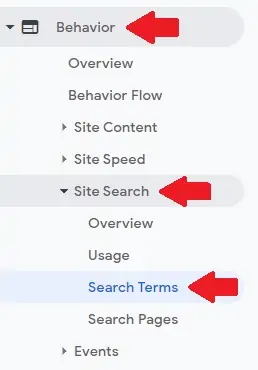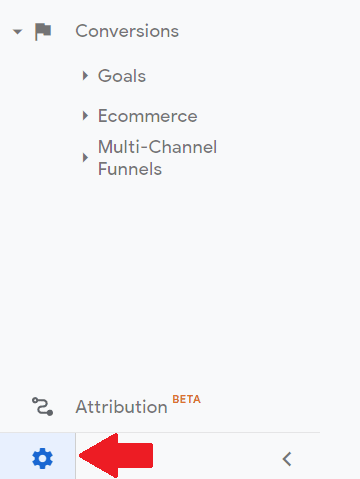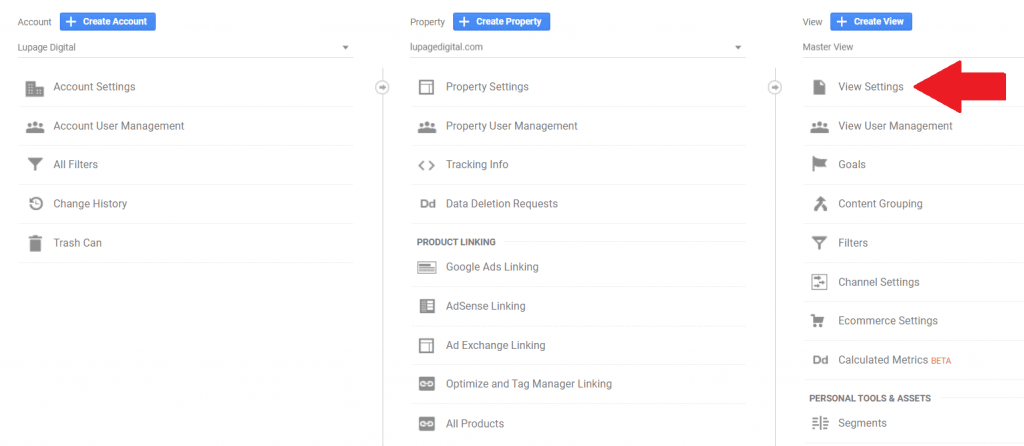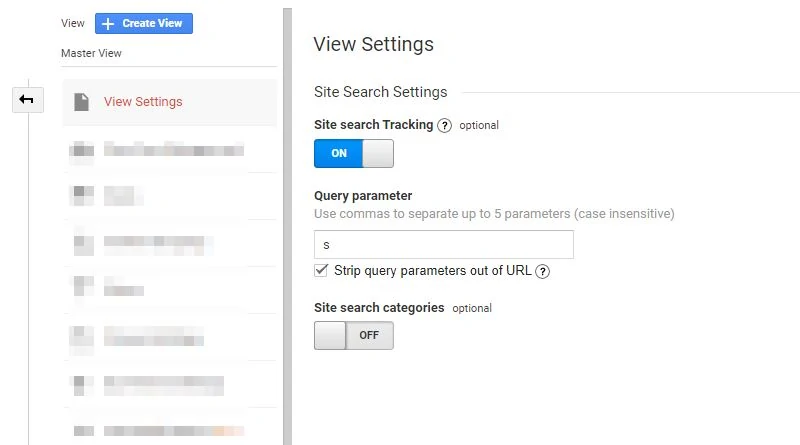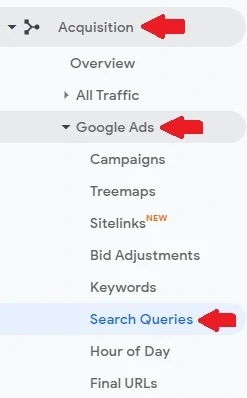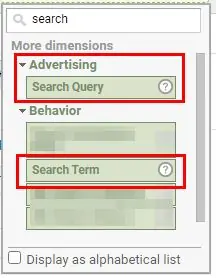Most optimizers gather data from Google Analytics to make business decisions. Whether keyword ranking or blog reports, there’s hidden data to get insights from.
If you’re buried in data, there’s another report that is a goldmine of information. Finding the right insights to make a decision is difficult. Sometimes it’s hard to know where to start or what data points are important.
Site Search Reports in Google Analytics
Most people don’t know that Google Analytics has a site search report. With Site Search data, you see the searches people are searching for on your site. This a fantastic information because of their level of engagement. Now you can focus on what’s important to your customers.
To access this dashboard go to Behavior > Site Search > Search Terms
This is one of the built-in reports in Google Analytics that marketers overlook. There are tidbits of information here that are useful for optimizing a website. This article highlights how to analyze and how to set it up for your Google Analytics accounts.
Setting Up Site Search On Your Website
Site search is the search box on your website. It’s the mini search engine embedded in the website. Most modern websites have them. Look at yours and it’s usually a bar or a magnifying glass. If you have these, then your website can track site search data. Here are mine:
Setting up site search would depend on your website or CMS (content management system). WordPress blogs already have a built-in site search. Almost all themes have them. Ask your web developers to add a search bar on your website if it makes business sense. Ecommerce websites benefit from site searches the most.
How To Turn On Site Search Tracking in Google Analytics
Site search is easy to turn on in Google Analytics. What’s interesting is most websites don’t have this tracking disabled. You can enable site search tracking on the View level. Note that there are many Views under a Google Analytics property. Ask a digital analyst to help out.
Note that this is for Google Analytics 3 (Universal Analytics), not Google Analytics 4.
1 – Go to Admin > View Settings.
2 – Under View Settings, scroll down until you see Site Search Settings. Turn it on.
3 – Add the Query parameter that that represents the site search page.
This is where it gets tricky. To set this up, you need to add the query parameters of YOUR website. Go to your website and do a “test” search. The URL that appears in the web browser is the site search page. The characters AFTER the question mark and BEFORE the equal sign is the query parameter.
Here are examples. The red color is the query parameter. You add these characters in the query parameter field box.
https://example.com?search=test
The query parameter is search
https://example.com?s=test
The query parameter is s
https://example.com?query=test
The query parameter is query
https://example.com?q=test
The query parameter is q
Most people make the mistake of adding the query parameter. The page path is added with the query parameter. This is an innocent mistake because the page path contains the word “search” (or any wording) that confuses people. Sometimes the question mark is also added in the field box.
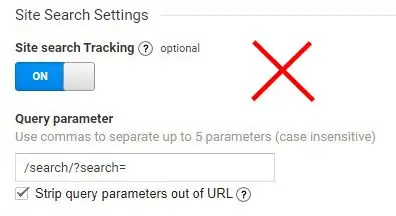
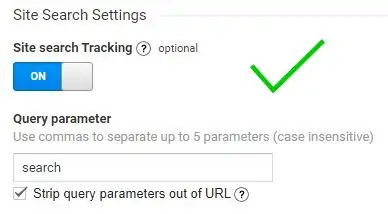
As mentioned, you add the characters AFTER the question mark and BEFORE the equal sign.
4 – Check “Strip query parameters out of URL”. You can choose not to turn on Site search categories for now.
5 – Click Save.
Do a test site search again and check if it’s working. Depending on your level of traffic, wait for a couple of hours or days. The dashboard populates with the necessary data. Note that query parameters from site searches are different from generated UTM codes.
How to Analyze Google Analytics Site Search Report
The site search report contains data on what users search for inside your website. What’s good about the site search data that it correlates to landing page engagements. Below is the definition of the metrics from the site search report.
| Metric | Description |
|---|---|
| Total Unique Searches | The number of times people searched your site. Duplicate searches within a single visit are excluded. |
| Results Pageviews/Search | The average number of times visitors viewed a search results page after performing a search. |
| % Search Exits | The number of exits from your site that occurred following a result of an internal search. |
| % Search Refinements | The total number of times a refinement (transition) occurs between internal search keywords within a session. |
| Time after Search | The average amount of time visitors spent on your site after getting results for the search term. |
| Avg. Search Depth | The number of pages visitors viewed after getting results for the search term. |
Now, there’s a simple way to analyze the site search report. Filter the data by Total Unique Searches in descending order. Then look at the highest % Search Exits. Or highest % Search Refinements. Or lowest Avg. Search Depth.
What does this filtering mean?
The terms that users search are not satisfied with the page results that they exit afterward. Think about it, the % Search Exit is high because the page is not relevant. If the searches are high with low engagements, there are improvement opportunities.
Another way is to filter the data by Total Unique Searches in descending order. Then look at the highest % Search Refinements. Search refinements are how many times users transition or change to a new search term. If they transition searches more, the search page doesn’t meet the needs of the user.
Site Search Showing No Results
The reasons why your website might not be gathering data or the site search is not working vary:
One reason is that the addition of query parameters might be misconfigured. You need to make sure that setting up is done properly. Ask for help from a web analyst.
Another reason is that your search bar might be hidden that users don’t know that your website has a search bar. Users might have had a hard time locating the search bar. So, it’s important to make the search bar obvious and welcoming. Install Hotjar to get user insights.
Site Search Report vs Search Query Report
In Google Analytics, there’s also a search queries report. It’s also a built-in report in Google Analytics. Go to Acquisition > Google Ads > Search Queries. Note that this is different from the site search report.
What’s the difference between these two?
The search query dimension under the Search queries report is Google Ads. This is not the site search report. What’s identical between these two data points is both pertain to what users searched for. They’ve done something on your website.
The difference is that search queries are what the users searched for that triggered Ads. Google Ads is the advertising platform from Google that runs paid search campaigns. These search ads get triggered through keywords. And it happens before users land on your website. And these keywords are the “search queries”, hence the name.
Going back, the site search report contains the “search term” dimension. “Search term” are search terms used by visitors to search your site. So, don’t get confused if you’re trying to get the appropriate data for your reports.
Conclusion: Start Site Search Tracking in Google Analytics
Google Analytics has many tools for measuring your website’s performance. The site search report in Google Analytics is the way to see what users are searching for on your website. You find insights that you’ve never seen before because you understand what users think about your site.

